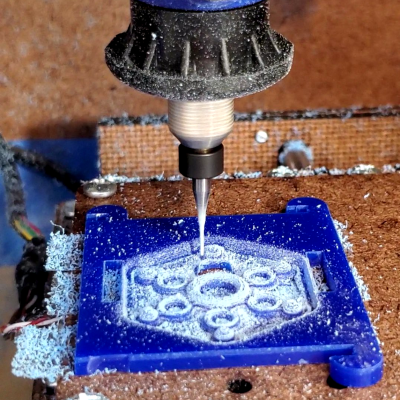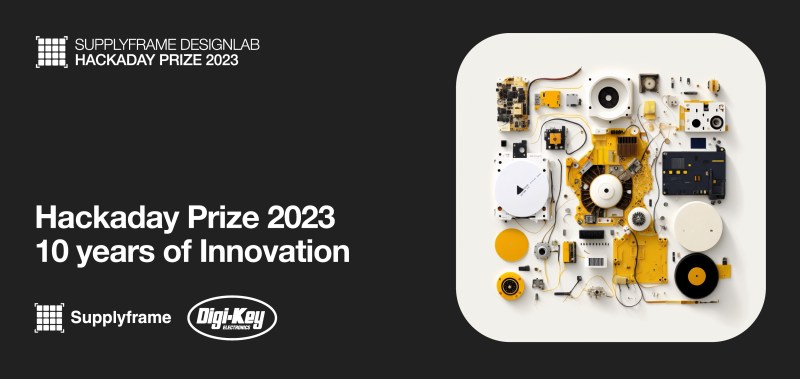If there’s more to life than just a workshop full of tools, it’s probably a workshop full of tools that you’ve built yourself. At least that was the thinking behind the recently concluded “Gearing Up” challenge of the 2023 Hackaday Prize, which unsurprisingly generated quite a list of entries for our judges to review and whittle down to their top ten favorite tools, jigs, fixtures, and general labor-savers.
Having piqued the interest of our crack team of judges, these ten projects have not only earned a spot in the 2023 Hackaday Prize Finals, but they’ll also get a $500 cash prize to boot. But the heat is really on now; like all the finalists from the previous rounds, they’ve only got until October to get their projects as far along as they can before the final round. The grand prize is grand indeed — $50,000 in cash and a residency at the Supplyframe Design Lab in Pasadena!
We’re really getting down to the wire here, but it’s worth taking a little time out to look at some of the Gearing Up challenge winners, and what they came up with to make life in the shop a little easier. And don’t forget — the one who dies with the most tools wins!
Wrangling Electrons
 Given Hackaday’s focus on electronics, it’s probably no real surprise that most of the Gearing Up finalists came up with tools designed to make prototyping circuits easier in some way. It’s an area that’s ripe for improvements, too, between rapidly shrinking components that make for a lot of fussy manual work.
Given Hackaday’s focus on electronics, it’s probably no real surprise that most of the Gearing Up finalists came up with tools designed to make prototyping circuits easier in some way. It’s an area that’s ripe for improvements, too, between rapidly shrinking components that make for a lot of fussy manual work.
One project that really caught the eye of the judges was Jumperless, the jumper-free solderless breadboard. Fiddling with jumper wires might seem like an essential part of the breadboarding experience, but not with Jumperless, which aims to replace all those wires with a matrix of analog switches. All you have to do is plug in your parts and make virtual connections on the companion GUI. Jumperless takes care of making the connections for you. Jumperless also has a bunch of built-in goodies, like DACs and ADCs, which can be switched in and out of the circuit under prototype as needed. It’s also got some LEDS embedded in the breadboard area, which can light up and provide visual cues about what’s connected to what. Pretty slick!
Once you get past the breadboard stage you’re going to need to start slinging solder, and that’s when most of us have probably had the experience of needing just one more hand than the OEM provided. Between the iron, a roll of solder, a pair of tweezers, and maybe a hot-air station, most of us have needed help at one time or another. Sure, there are plenty of “helping hands” fixtures, but what’s the point if you’ve got to drop your tools in the middle of things to set one up? Enter this work-holding robot arm, an Alexa-compatible articulated arm that you can whistle up when you need help. The 6-DOF robot arm can swing into action when you need it most, to tweak the position of a PCB for optimal access. There’s also a set of fixed gripper jaws that can get in on the action, making this a complete co-working suite. This really feels like one of those “Why didn’t I think of that?” ideas, and the judges seem to agree.
Now that your circuit is built, what about decoding? In keeping with “the most tools” sentiment, many of us sport quite a collection of test instruments, and the “wall o’ gear” is something many of us aspire to. But what if you need to go mobile with your test setup? Are you going to lug around racks of equipment just to take a few simple measurements in the field? Of course not, which is the rationale behind Felini, the electronics lab in your pocket. Billed as a “Swiss Army knife of electronics,” Felini packs a ton of functionality into a tiny package with a touch-screen interface. It’s optimized for embedded applications, supporting DAP Link debugging, RS485, I2C, CANBus, servo testing, and Neopixel testing, too. It also has built-in GPIO pins that can be configured for voltage measurements, frequency counting, and general-purpose timing applications. Sure beats lugging around all that extra gear.
Hardware Helpers
Electronics prototyping wasn’t the only place our Gearing Up entrants shined, of course. Every trade has its pain points, after all, and it doesn’t take much pain before somebody gets to thinking that there has to be a better way. We were lucky enough to have a few of these kinds of projects show up in this round, too.
If you’ve done any cybersecurity work, chances are pretty good you’ve got a laptop kitted out with a suite of tools that let you get your job done quickly and easily. But one laptop pretty much looks like another, and where’s the fun in rolling up to a job looking like everyone else? Well, if you bust in with CyberSecDeck-001, you’re certainly going to make a statement! A cross between a cyberdeck and a server room crash cart, this platform is sure to command attention. From its tacti-cool chassis to the Kali Linux inside, everything about this oozes cyberpunk cred, especially its host of bolt-on accessories.
 Back in the lab, you might have a need for something like this DIY Spin Coater. If you need to apply a thin layer of liquid to a flat surface — think photoresist on a blank copper-clad board — nothing beats a spin coater for fast and consistent results. This one sports a powerful BLDC and controller to really get things going, and is powerful enough that it can spin out a thick, goopy blob of silicone evenly over a PCB.
Back in the lab, you might have a need for something like this DIY Spin Coater. If you need to apply a thin layer of liquid to a flat surface — think photoresist on a blank copper-clad board — nothing beats a spin coater for fast and consistent results. This one sports a powerful BLDC and controller to really get things going, and is powerful enough that it can spin out a thick, goopy blob of silicone evenly over a PCB.
And finally, if you prefer to mill your PCBs rather than etch them, you’ll need to check out the Minamill 3DP. While it’s generally true with machine tools that bigger means better, there are plenty of situations where a small, light-duty machine can shine. The Minamill aims to capitalize on that fact, making up for what it lacks in power and rigidity with persistence and precision. Made mostly from 3D-printed parts, Minamill turns out some fantastic small parts. We’re particularly impressed with the PCBs it creates — just think of the precision required to take off the copper layer and only the copper layer, and leave traces down to 0.2 mm behind. It looks like a fantastic tool to have on the bench next to you for rapid prototyping.
Gearing Up Finalists
- DIY Spin Coater
- Jumperless
- Felini – Revolutionary Pocket-Sized Electronic Lab
- Low-Cost Universal Tensile Testing Machine
- UV projection printer for PCBs and item marking
- 10kW (30kW pulse) Electronic Load
- OMOTE – DIY Universal Remote
- CyberSecDeck-001
- Work-holding Robotic Arm for Electronic Workshop
- Minamil 3dp: another minimal CNC mill
Are We There Yet?
It may be hard to believe, but yes, we’re almost at the end of the 2023 Hackaday Prize. We’re currently deep into the final challenge, the Save the World Wildcard, where pretty much anything goes. If you haven’t started your Hackaday Prize entry, now’s your time, and the clock is ticking — the challenge closes at 7:00 PM PDT on September 12, 2023. So get going!
And we’d be remiss not to thank our sponsors for their generous help in making the 2023 Hackaday Prize possible. Thanks!


















D’oh.
@Dan Maloney the “Minamil 3dp” pic here is from the earlier laser-cut version (retronymously “2dc”). Maybe swap in https://cdn.hackaday.io/images/3980021691450688776.jpg from this year’s contest entry and delete this comment?
Thanks for saying nice things about my project!
Congrats to all finalists! Well deserved!
Full steam ahead for the few last seconds of the wildcard! :)
This is the third time I have been a finalist, and it’s an honor for me to be part of this group of inventors! …I’m also proud of the 10 years of Hackaday Prize!